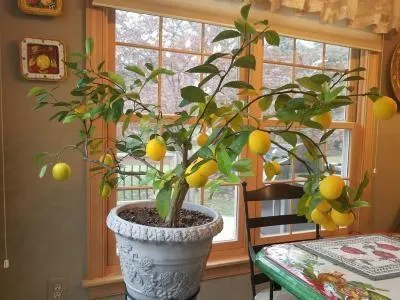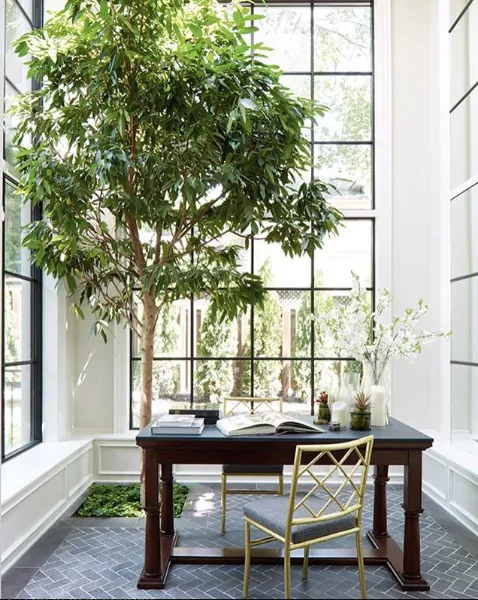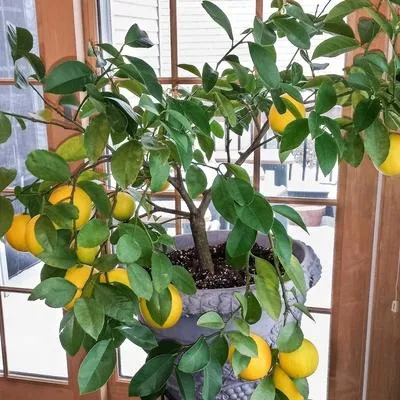Your Guide to Choosing the Perfect Small Indoor Tree Plant
Searching for low-maintenance indoor plants to add life and greenery to your home? Small indoor tree plants are a terrific option that can thrive even with limited natural light. There are many varieties suitable for growing inside that stay relatively compact. Below you’ll find answers to common questions about selecting and caring for a miniature indoor tree.
What Types of Small Trees Work Well Indoors?
A few top choices for small indoor tree plants include:
- Dwarf Ficus trees: These colorful options like fiddle-leaf fig stay under 5 feet tall and are very low maintenance. They clean the air and are tough enough for low-light areas. From my experience, their waxy leaves attract dust but their unique shapes are striking decorative elements.
- Dwarf Olive trees: Miniature olive varieties max out around 4 feet tall and are striking in smaller spaces. Care is simple—water when soil is dry. Their realistic olive fruits in fall and winter add unique touches. I’ve kept one thriving indoors for over 5 years with once weekly watering.
- Dwarf Schefflera: Also called dwarf umbrella tree, this compact variety stays small, under 3-4 feet. They thrive in medium light and are very forgiving of occasional dry spells according to nursery owners I’ve consulted. Their unusual umbrella shape is fun conversation starter.
What Traits Should You Consider?
When selecting an indoor tree plant, focus on varieties known to tolerate lower light conditions. Size is important too—choose dwarf or miniature selections that will fit your space. Consider how low-maintenance the plant usually is as well to match your care schedule.
Traits like drought tolerance, pest/disease resistance, and growth rate impact care needs. For example, in my experience fiddle-leaf figs can be finicky but olive trees are nearly impossible to kill. Check plant tags or research individual varieties to understand their typical growing conditions and preferences.

How Do You Care for an Indoor Tree Plant?
Proper care involves providing the right growing conditions and routine maintenance. The basics include:
- Light: Place in a spot with bright, indirect light from an east or west-facing window. Many smaller tree varieties tolerate low light but will thrive and stay compact with moderate light.
- Watering: Allow top 1-2 inches of soil to dry between waterings. Check soil moisture frequently with your finger and water thoroughly when dry. Use distilled, filtered, or rain water if possible to avoid minerals that can harm leaves.
- Humidity: Run a humidifier, place on a pebble tray with water, or group with other plants to boost humidity which most indoor trees appreciate. Leaves will yellow or brown if air is too dry.
- Feeding: Apply a balanced, water-soluble houseplant fertilizer diluted to 1⁄2 or 1⁄4 strength monthly during spring and summer.
An important tip though—sometimes less is more! Overwatering and overfertilizing are way more common problems than underwatering from my experience raising indoor trees. Go by the plant, not the schedule. Adjust care according to how it responds rather than sticking rigidly to routines.
How Do You Keep an Indoor Tree Small?
While miniature tree varieties stay compact naturally, you can also control size through pruning. Trim back new shoots in spring to encourage branching and fuller growth lower down. Snip off entire branches if a tree begins to outgrow its space according to arborist experts. This keeps it shapely and balanced. Stake tall leggy specimens to prevent wind rock from distorting the trunk as well. Another option is repotting regularly to contain extensive root systems. With the right conditions and pruning strategies, indoor trees can remain petite and perfect for small spaces indefinitely!
What Challenges Might You Face?
Basically, the main problems that can crop up involve either too much or too little of the necessary care elements like water, light, fertilizer, etc. Signs of underwatering include wilted, crispy leaves while overwatering will result in soggy soil and yellowing foliage from root rot. Pests threaten indoor plants too—look out for spider mites, aphids or scale insects especially on new acquisitions according to the nursery manager I chat with. Most pests can be eliminated with neem oil or insecticidal soap sprays. Ultimately, getting to know your plant’s particular likes and needs is key from what I’ve found through trial and error with my mini indoor jungle over the years! Regular pest checks, adjustment of care according to visual signals, and accepting that not all plants will thrive are part of keeping them happy at home.

Any Tips For Plant Placement?
Beyond just light requirements, think about pleasing aesthetics too when placing your new indoor tree. Arrange groupings for maximum visual impact. Surround a lone focal plant with pots of trailing vines, smaller foliage, or flowers for visual interest. Taller upright varieties work well as living room dividers or standing alone as tabletop accents with their artistic shapes. Consider décor as well for harmony—a bold leaf pattern pairs beautifully with an earthy macrame hanging plant holder. And experiment with creative containers beyond traditional nursery pots. I’ve seen lovely dwarf olive trees thriving for years in repurposed wicker baskets, glass hurricanes or rustic wooden vessels. Think outside the nursery pot! With imagination and trial, little indoor trees can add big personality anywhere inside your home.
In summary, small indoor tree plants bring style and life to any living space! Though typically very tolerant, care does require understanding each variety’s light, water and growing needs. With strategic placement and ongoing watchfulness, you can keep your little trees thriving for many years. As always when I bring home a new plant, observing its initial establishment period closely is important too. Have fun choosing complementary pots and placements that highlight nature at a petite scale indoors. A miniature indoor forest is easier than you think to achieve and care for with just a bit of know-how! Good luck to all enthusiasts seeking that special miniature tree for their home – the possibilities are endless.
Top 5 Small Indoor Trees for Your Home
| Tree | Size | Water | Light | Care |
|---|---|---|---|---|
| Jade plant | 2-3 feet tall | Allow soil to dry between waterings | Bright indirect sunlight | Needs occasional pruning; tolerates low light |
| ZZ plant | 1-3 feet tall | Allow soil to dry before watering | Tolerates low light | Low maintenance; resistant to pests and disease |
| Rubber plant | 2-6 feet tall | Water when top inch of soil is dry | Bright indirect light | Needs occasional pruning; tolerant of low light |
| Dracaena | 2-5 feet tall | Water when top inch of soil is dry | Tolerates low light | Low maintenance; air purifying properties |
| Ficus | 2-6 feet tall depending on variety | Water when top inch of soil is dry | Tolerates low light | Needs occasional pruning; air purifying properties |
FAQ
-
What kinds of small trees can I grow indoors?
There are quite a few plants you can use as indoor trees. Some popular choices are: Chinese evergreen, dwarf date palm, ficus, bamboo palm, dracaena. These trees don’t get very big but add nice greenery to a room.
-
How much sunlight do indoor trees need?
Most small indoor trees require moderate to bright, indirect sunlight. Direct sunlight coming through a window can scorch their leaves. East or west facing windows tend to offer the perfect conditions. North windows don’t provide enough light. To be sure, check the light requirements for whatever type of tree you choose.

-
What size pot do I need for an indoor tree?
The container you choose depends on the size the tree will reach as an adult. Get a pot just slightly bigger than the root ball. Re-pot into something larger every couple years. As a basic guideline, when the tree is young use a 6-inch pot and upsize to 8-inch and 10-inch pots as it grows. Go bigger if it will be a large plant eventually.
-
How often do indoor trees need watering?
Water requirements change based on the tree type and seasonal conditions. Basically, water when the topsoil becomes dry. Check by touching the soil or using a moisture meter. In warmer months, water every 5-7 days. Cut back to every 10-14 days in cooler weather when growth slows. It’s smarter to underwater than drown the roots with overwatering.
-
What kind of care do indoor trees need?
Indoor trees need the normal basics like water, light and fertilizing. Make sure to occasionally wipe leaves clean of dust. Repot into larger containers as roots fill the pot. Prune off any dead or diseased branches. In winter when growth stops, cut back on water until spring. With regular care like that, your little tree should stay attractive for many years.
-
Are indoor trees difficult to care for?
In general, no. Many small indoor tree varieties are low maintenance. They don’t require constant work or attention like a big outdoor maple. Just provide proper light, water when soil seems dry, and fertilize during growing season. Of course, large trees may need more TLC than bonsai or miniature varieties. Overall as a whole, indoor trees are fairly uncomplicated to sustain.

-
Should I be worried about pests with indoor trees?
It’s unlikely, but indoor trees aren’t fully pest-proof. Occasionally issues like spider mites, scale or mealy bugs may appear. Keep an eye out for unwanted guests. Wipe leaves weekly with diluted neem oil or insecticidal soap as prevention. Isolate any infested plants right away. Healthy trees in good conditions often avoid bugs. So no need to panic, just be vigilant with inspections.
-
Will my indoor tree eventually get too big?
Potentially, yes. While they start small, some tree varieties can expand to sizes unsuitable for indoor conditions. Proper care and repotting into progressively larger containers can slow growth. However it pays to ID the mature dimensions before choosing a specimen. Alternately, think of trees as special display plants and rehome them outside in a garden when too massive for indoors.
